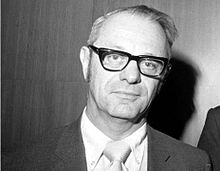Igor Ansoff
Appearance

Harry Igor Ansoff (December 12, 1918 – July 14, 2002) was a Russian American applied mathematician and business manager. He is known as the father of strategic management.
Quotes
[edit]Corporate Strategy, 1965
[edit]Igor Ansoff, Corporate Strategy: an analytical approach to business policy for growth and expansion, 1965
- This theory maintains that the objectives of the firm should be derived by balancing the conflicting claims of the various 'stakeholders' in the firm: managers, workers, stockholders, suppliers, vendors. The firm has a responsibility to all of these and must configure its objectives so as to give each a measure of satisfaction. Profit which is a return on investment to the stockholder is one of such satisfactions, but does not receive special predominance in the objective structure,
- p. 34; Cited in: Russell L. Ackoff (1994), The Democratic Corporation. p. 37
- We shall approach practical objectives through a series of approximations. Keeping the maximization of the rate of return as the central theoretical objective, we shall develop a number of subsidiary objectives (which the economists call proxy variables) which contribute in different ways to improvement in the return and which are also measurable in business practice. A firm which meets high performance in most of its subsidiary objectives will substantially enhance its long-term rate of return. (The defect in our approach is that we cannot prove that the result will be a ‘‘maximum’’ possible overall return.) As will be seen, this road has its own obstacles: the difficulties of long term maximization are replaced by the problem of reconciling claims of conflicting objectives.
- p. 47; cited in: Graham Kenny, (2012),"From the stakeholder viewpoint: designing measurable objectives", Journal of Business Strategy, Vol. 33 Iss: 6 pp. 40-46
- By searching out opportunities which match its strengths the firm can optimize the synergistic effects.
- p. 91
- The triplet of specifications - the product-market scope, the growth vector and the competitive advantage - describes the firm's product-market path in the external environment.
- p. 110
- A natural companion to the competitive advantage is the synergy component of strategy. This requires that opportunities within the scope possess characteristics which will enhance synergy.
- p. 165
Quotes Igor Ansoff about
[edit]- Ansoff (1965) gives only some indication of what he means by environment. This can be explained by Ansoff's classification of decisions into strategic. administrative and operating decisions. He (1965, p. 8) defines these types of decision as follows:
- Strategic - to choose product-market mix
- Administrative to structure the firm's resources for optimum performance
- Operating - to optimize the realization of the profitability potential with the present strategy.
- Göran Asplund (1975), Strategy formulation: an intervention study of a complex group decision process. p. 22
- The publication of the book, Corporate Strategy, by H. Igor Ansoff was a major event in the 1965 world of management. As early as it came in this literature, the book represented a kind of crescendo in the development of strategic planning theory, offering a degree of elaboration seldom attempted since.
- Henry Mintzberg (1994), The Rise and Fall of Strategic Planning, Prentice Hall, Hemel Hempstead. p. 43
- The stakeholder concept was originally defined as "those groups without whose support the organization would cease to exist." The list of stakeholders originally included shareowners, employees, customers, suppliers, lenders and society. Stemming from the work of Igor Ansoff and Robert Stewart (in the planning department at Lockheed) and, later Marion Doscher and Stewart at SRI, the original approach served an important information function in the SRI corporate planning.
- R. Edward Freeman (2010) Strategic Management: A Stakeholder Approach. p. 32

